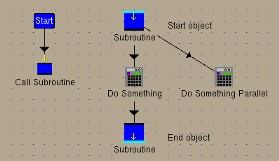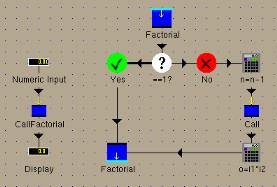
Using subroutines
Subroutines are meant to be a group of objects which are called from
multiple points in the program and return execution to the point where
they were called from.
There are three objects which provide the functionality of subroutines:
A "Subroutine" object and a "Return" object which define beginning and
end of a subroutine and a "Call" object which is used to execute
the subroutine. Figure 1 shows all three subroutine objects.

Fig. 1: Subroutine objects
Defining a subroutine
For defining a subroutine insert at first a "Subroutine" object. In the
property dialog specify the subroutine name and the input variables. These
variables appear as input variables of the appropriate "Call" objects and
as output variables of the "Subroutine" object. At the end of your
subroutine insert a "Return" object. In the property dialog at "Belongs to" choose the
"Subroutine" object the "Return" object belogs to. Then specify the
variable that contain the return values of the subroutine. These variables
appear as input variables of the "Return" object and as output variables of
the appropriate "Call" objects.
During execution "Return" objects have the following special behaviour:
If executed the "Return" objects wait for all parallel executing threads
of a subrouting to finish. In Figure 1 this means that the subroutine
does not return until the object "Do Something Parallel" has finished. If
the "Return" object is called when executing a non parallel sub branch, the
sub branch does not return to the point it originated but the subroutine returns immediately.
Calling a subroutine
Insert a "Call" object into the workspace. Within the property dialog specify at "Called routine" the name
of the subroutine which should be called. This routine can be on any workspace panel. After that press "Update Variables"
to synchronize the "Call" object's input and output variables with the variables of the subroutine. If you change
input and output variables of a subroutine, you need to update all "Call" objects calling the subroutine. This is not done
automatically for security reasons.

Fig. 2: Recursive calling
Recursive calling of a subroutine is explicitly allowed. Figure 2 shows an object layout that can
be used to recursively calculate a factorial number, although this is quite inefficient in this case as a new thread tree
is created on each recursion.
The Vimms User Manual








